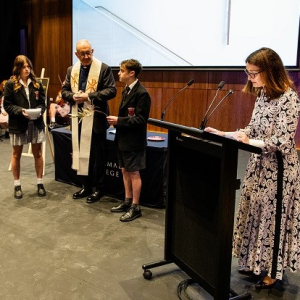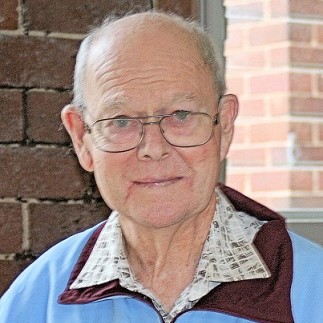Peter MALONE
Lisa Frankenstein
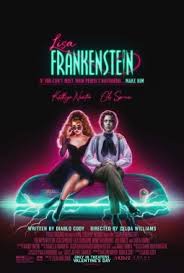
LISA FRANKENSTEIN
US, 2024, 101 minutes, Colour.
Kathryn Newton, Liza Soberano, Cole Sprouse, Carla Gigino, Joe Chrest, Henry Eikenberry, Bryce Romero.
Directed by Zelda Williams.
For a while at the opening of the film, this seems to be just another high school comedy/drama, the target audience seeming to be the kind of girls that were portrayed. A very limited audience.
However, there are indications that this film will be not exactly what we might be anticipating. There is a clue when we see that the screenplay was written by Diablo Cody, Oscar winner for Juno, her films including Jennifer’s Body, and a focus on fiction for younger readers, Tully, Young Adult and the screenplay for the Meryl Streep musical vehicle, Ricki and the Flash.
The central character, Lisa, is played by Kathryn Newton (Big Little Lies). The mother has been killed by an intrusive burglar, visualised), her father soon married again, Lisa inheriting a kind of wicked stepmother of the constant criticism kind, played by Carla Gugino, and a welcoming sister, Taffy (Liza Silverado).
But, Lisa is emotionally erratic, sometimes withdrawn, sometimes prickly, spending a lot of time in the forest, a cemetery where she sees the bust of a young musician from the 19th century with whom she becomes infatuated.
And, unpredictably, it goes on from there, probably testing the patience of many viewers, tantalising others so much so that there are predictions that it will become a cult classic.
We are soon moving into Tim Burton territory, touches of Beetlejuice, memories of Edward Scissorhands with the Creature plaintively resembling a mute Johnny Depp as Edward.
The film is billed as a coming of RAGE film, the young musician struck by lightning and coming alive, billed as The Creature (played by Cole Sprouse), so, echoes of Frankenstein. Lots of complications as the Creature takes up residence in the house, hiding and sleeping in the cupboard, mute with several body parts missing. A possible romance, especially on his part, memories of his grief in his real-life, but Lisa with her eye on a sexual liaison with the editor of the school magazine who has praised her poems.
So, while the film works on this strange Frankenstein variation, it becomes very violent, The Creature impulsively acting on Lisa’s behalf, the death of her stepmother, the mutilation of her science lab partner who groped her, and increasing threats.
On the other hand, there is something lyrical about The Creature at home, gradually looking more human, acquiring more parts, the hand of the groper, able to play the piano, the stepmother’s ear, and (a critic suggested moving into John Waters territory) killing and castrating the would-be lover and taking his penis.
Complications at school, complications with the family, especially with the typical teenager new sister whom she catches with the editor.
What is Lisa to do, to live eternally with The Creature, going into the tanning machine, burning up – and a glimpse of eternity, The Creature reading to the reclining Lisa, a poem by Shelley.
One might say you couldn’t make it up – but Diablo Cody has, the cast is obviously very committed to it, and direction is by Zelda Williams, her first feature film after many music videos.
Cult classic? But it certainly is different!
Jefferson in Paris

JEFFERSON IN PARIS
US/France, 1995, 139 minutes, Colour.
Nick Nolte, Greta Scacchi, Jean-Pierre Aumont, Simon Callow, Seth Gilliam, James Earl Jones, Michel Lonsdale, Nancy Marchand, Thandiwe Newton, Gwyneth Paltrow, Lambert Wilson.
Directed by James Ivory.
Merchant-Ivory have moved from E.M. Foster country and period, A Room with a View, Howard’s End as well is their great success previous to this film, Remains of the Day to Paris in the late 1780s with a portrait of Thomas Jefferson during his period as American ambassador - which included the French Revolution.
Sets, decor, costumes and photography are meticulous and will exhilarate many audiences. Many reviewers express the wish that plot, drama and conflict and acting matched the texture of the film. Nick Nolte does his best as Jefferson, but his character does not engage interest and sympathy.
There is a strong supporting cast led by Greta Scacchi. However, they are often given rather arch dialogue, aping an 18th century English style which makes it sound a touch `precious' and pretentious. (Some would mean that one commentator referred to “prigs in wigs”). However, for those interested in the period, it offers perspectives on the Revolution and how it affected the man who was to become president. Strong period setting - less strong drama.
- The reputation of the Merchant/Ivory films, literary adaptations, period, meticulous attention to detail, costumes and decor?
- Audience knowledge of Jefferson, in the revolution, founding father, relationship with Washington, sent as US Minister to France? Audience knowledge of this pre-Revolution French history?
- The focus of Jefferson, Nick Nolte’s presence and performance? In the War of Independence, his home and household, wife, daughters, widower though not to remarry? Sent to France, his response to 18th century pre--Revolution France, culture?
- The setting pre-Revolution, Versailles, costumes and décor, the court, corruption?
- The range of locations: The Hotel de Laungeac, Lafayettes, Versailles, the Panthemont Abbey, Dr Mesmer's, The Opera, The Palais Royale, Pike County, Ohio?
- The episode with Dr Mesmer?
- Jefferson himself, his age, widower, diplomatic skills, his interest in the arts, sciences, dismay at the poverty of France?
- The portrayal of Jefferson as a person, his marriage and devotion to his wife, not to remarry, his relationship with his daughters, with Polley, with Patsy? The encounter with Maria Cosway, her marriage, her husband, artist, musician, the relationship, her devotion to him, strengthening the relationship? The hostility of his daughters? And his vow not to remarry?
- The character of Sally Hemmings, a relationship, his wife’s heart sister, the family background, the slavery, mixed-race families? James Hemmings, Sally’s brother, studying to be a chef in Paris, the intention for his return to Monticello? The break with Maria Cosway?
- Washington, the invitation for Secretary of State, his decision to return? Sally and her pregnancy? Not wanting to return, James not wanting to return? Jefferson, his oath and commitment to their freedom?
- The film as a different perspective on the founding fathers, on the US at the period, the Constitution, Bill of Rights, issues of slavery and freedom, the status of the United States abroad?
Poison/ 2024
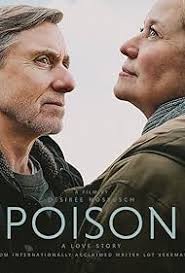
POISON
Luxembourg, 2024, 86 minutes, Colour.
Tim Roth, Trine Dyrholm.
Directed by Desiree Nosbusch.
This is a production from Luxembourg, director from Luxembourg, the filming there, the audience appreciating some of the beauty of the city, the water and bridges, the forests, the mountains.
This is a film of dialogue and so it is not surprising to find that it is originally a play for the theatre, adapted by the playwright, Lot Vekemens, who is from Holland. The film has a female sensibility from the director and the writer.
Poison is a very strong title. However the reference is not to physical poison but to poison of the emotions of the mind, suddenly caused by an unexpected accident, the death of a child, and the ability and inability of each parent to deal with the grief, and to work with each other in the tragic situation, the husband leaving, finding another wife, another child, the mother staying.
The scenario has news of alterations being made in the cemetery and so the couple coming together, she trying to avoid her ex-husband but, finally, their engaging in strong conversations, a range of moods, guilt issues, blame issues, acknowledgement of the issues. And, for the film opening out, less stage-bound,, there are several locations for continuing the conversations, in the cemetery office, outside in the cemetery grounds, a long conversation in a church, with rain and conversation in the front seat of the car, and, eventually, a long walk up a mountain road, some powerful sequences, especially a long single take sequence the camera focusing on the couple and their interchanges as they walk up the mountain.
Ultimately, there is some kind of reconciliation, the husband positing the possibilities for hope or piece and the wife saying, ‘both’.
The two actors do more than justice to the dialogue, a different performance from Tim Roth, who has had a career of more than 40 years in Britain and in the United States. The wife is played by Danish actress Trine Dyrholm, winner of many prestigious awards appearing in many classic films including Margritte, Queen of the North, the Commune, Queen of Hearts.
- The poison of the title, dire circumstances, grief, the consequences, guilt and blame? The need for eliminating the poison, especially after it festers for years?
- The film based on a play, the focus on dialogue, a two hander and interactions, the limited locations, character and verbal drama?
- Writer and the director, Luxembourg background, filming there?
- The impact of the location photography, the roads and highways, the coast, the mountains, town and views, the cemetery, the church and interiors, walking the mountain parts? The musical score?
- The gradual revelation of the relationship between Lucas and Edith, the marriage, tensions, the death of their child, different ways of coping, grieving, Lucas and his leaving, a further relationship and child, Edith staying, making a life for herself, her work, but alone?
- The introduction to each character, Lucas, leaving home, his driving, at the sea, the coffee, taking time to reflect, going to the cemetery? The contrast with Edith, busy at home, her garden, the bicycle, riding through the town, arriving at the cemetery, in the office, initially trying to avoid Lucas?
- The dialogue creating the tension between the two, the audience not quite sure of the reasons? Edith, inattention, avoiding Lucas, the revelation of 10 years’ separation, yet her memories of the past, wary of interaction with him? The importance for Lucas of meeting Edith again, for some kind of resolution?
- The revelation of character through the dialogues, hostilities, explanations, detailed memories, accusations, defences, the changing of moods, Edith and her explanation of her life over the decades, Lucas and his marriage, child, the story about his joining the choir and its effect? Her laughing, their laughing?
- Something of a rapport between them, bridging the 10 years, Edith’s demands on Lucas’s memory, his memory of details, driving away, thinking he should turn back, but couldn’t? And remembering the dead child every day? As did Edith?
- The locations, the discussions in the confined office, going outside, the long conversations in the church and the religious atmosphere and background, the rain, in the car, going to the final walk? The locations affecting the mood of the conversation?
- The satisfaction for each in the meeting, talking, some mutual understanding, moments of forgiveness, and embrace, the returning to their lives?
- The final aerial overview of the city, Edith and her bike, the water on the bridge, the forests? And leaving the audience to contemplate their response to each of the characters, to the sad situation, irrevocability, failures, grief, hopes? And the issue of whether one could have peace or hope, and Edith replying, both?
Tori and Lokita
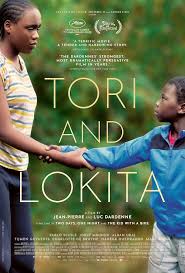
TORI AND LOKITA
Belgium, 2022, 88 minutes, Colour.
Pablo Schils, Joely Mbundu, Alban Ukaj.
Directed by Jean-Pierre Dardenne, Luc Dardenne.
Since the late 1970s, the Belgian brothers, Dardenne, have been making significant social-minded films, appeals for justice, greater social awareness. An interesting comparison with the films are those of Britain’s Ken Loach.
The films tend to be small and focused, Belgian, Belgian society, and changes over the decades. By the 2020s, the brothers are focused on migrants, refugees, visas and papers, illegal migrants.
The names and the title belong to refugees from Morocco. The focus is on Lokita, late teenage, being interviewed for her papers, a made up story with the help of the younger Tori, that he is her brother, was associated with sorcery at his birth, taken from family, at an orphanage, now in Belgium. She fails the interview.
The audience is surprised to find that the two youngsters are involved with drug dealing, couriers for the owner of a kitchen, a number of associate thugs who are brutal and violent, rival dealers, even amongst the migrants from Africa.
The film is very sympathetic, the portrait of the two youngsters, their relationship, friendship love and dependence. It shows in some detail, their work in dealing, the clients, the financial issues. Ultimately, Lokita is given the opportunity to hide, to get falls papers, to be a caretaker for an indoor hothouse growing drugs.
The film builds up to a dramatic conclusion, the two youngsters, an attempt to escape – and the reminder that there is very little possibility for escape.
- Topical social drama, Africa, Europe? Refugees, visas, work and survival, exploitation?
- The Belgian setting, the Belgian city, interviews and the authorities, kitchens and restaurants, drug dealing, the range of clients, in the streets, buildings, the cultivation of the drugs, side hothouse, the countryside? The musical score?
- The focus on Lokita, her age, the interrogation for papers, a story about rescuing Tori, his coaching her, the questions and answers, the range of interviews, her ultimately failing? Her accommodation? The bond with Tori, his being at school? Tori, his age, his background story, associated with sorcery, taken from his parents, at the orphanage? His presence in Belgium? His papers? Lokita and her coming from Morocco, getting money to send to her mother, these for the children to go to school?
- The world of drug dealing, young people and their being used, the main dealer, Betim, his work in the kitchen, the drugs, the range of clients, his treatment of the youngsters, payments, the focaccia, his associates, Margot and Lucas, the pressure on the children? The rival dealers? Firmin and the African connections?
- The scenes of the dealing, the meetings, the money, the phone calls, payment? The attack on Lokita, Margot and the pressure, finding the money? The threats?
- The decision for Lokita to live in the warehouse, her room, the setup, locked in, the in-house growing of the plants, her work? Her wanting to phone Tori? The arguments?
- Tori, shrewd, in the car, finding the warehouse, getting in, contact with Lokita, the phone, the threats, the decision to escape, out of the building, onto the road, hitchhiking, Tori hiding, Lucas and his finding Lokita, the pursuit, his shooting her?
- The end, the exploitation of the people from Africa, a challenge to the conscience of Europe?
Thief's Daughter, A/ la hija di un ladron

A THIEF’S DAUGHTER/ LA HIJA DI UN LADRON
Spain, 2019, 100 minutes, Colour.
Greta Fernandez, Eduard Fernandez, Alex Monner, Tomas Martin.
Directed by Belen Funes.
A Spanish slice of life, a modest film, but screened successfully at many festivals, winning awards.
The setting is Barcelona, the focus on Sara, young, wearing a hearing aid, with a young child, the father absent working in France but not wanting to follow up on his relationship with her. She lives in accommodation provided by official social services, friendly with others in similar situation. She applies for various jobs, is seen in various cleaning jobs, working in kitchens, hard-working with the possibility of permanent employment in a kitchen.
There are several family complications, the return of the father of her son, his friendliness, support but not a relationship. There is the younger brother, disabled, at school, needing care, her wanting to get official custody and going to court for this. The complication is that of her father, his absence, getting out of jail, his return, his erratic attitudes towards his children, some happy moments, some harsh moments, a celebration of the young boy’s first communion and a party afterwards. But, the father is harsh, makes promises to Sarah which he will not fulfil, threatening her, and the case, ultimately going to the court, Sarah trying to make a presentation, answer the questions from the lawyers, but the audience left in uncertainty as to the verdict.
The film stops, relies on the impact on the audience up to this point, their sympathy for Sarah and her application to have custody of her brother – but, the camera looking at her, the situation open.
- A Spanish slice of life, ordinary people, lives of hardships?
- The Barcelona setting, the city, the suburbs, social housing and apartments, school, church celebrations, cleaning jobs, kitchen work, the courts…? The musical score?
- Sarah’s story, her age, background, relationship with her father, his time in jail, absence, getting out? Her relationship with Dani, his being away working in France, his return, kind but not loving, no relationship? Her devotion to their son, continued care? Her disability with her hearing, her hearing aid? The prospects?
- The work scenes, the women working, the jobs, cleaning, kitchen work, Sarah and her eagerness, carrying the fruit cases, the possibility of a full-time job, accepted? Accommodation, Dani and his promises, her father and promises and his not fulfilling them?
- Martin, his age, her brother, the absent father, his being in care, his disability, his moods, relationship with Sarah, his father’s return, the first communion, the party and celebration? Sarah wanting custody of him? Defying her father?
- The scenes between father and daughter, the past tensions, his reaching out, yet his selfishness, lying to his daughter and his promises, with Martin? The confrontation at the kitchen, Sarah walking away, her decision to contender custody?
- Her going to court, the lawyer, the preparation of the questions, her nervousness, the judge, her father not appearing, the questions, her hesitant answers, not knowing what to say?
- The final image, the film not giving a final solution, over the audience, looking at Sarah, knowing her, the situation, the audience opinion as to what the judgement should be?
This Time Next Year

THIS TIME NEXT YEAR
UK, 2024, 115 minutes, Colour.
Sophie Cookson, Lucien Laviscount, Golda Rosheuvel, Mendip Gill., Monica Dolan, John Hannah,
Directed by Nick Moore.
A British romantic comedy, British style, a story of 30-somethings. The film is based on a novel by Sophie Cousens who has also written the screenplay.
Audiences who like a London stories will feel very much at home, the suburbs, mansions, the Underground, buses, pastry shops, the business world… But, there is a difficulty with identifying with the central character, Minnie Cooper (Sophie Cookson). She has a certain amount of charm, but… She is extremely accident-prone which we discover almost immediately, with accidents recurring throughout the film.
But, it is because one of these accidents that she encounters a charming young man, the Prince Charming equivalent, Quinn (Lucien Laviscount well-known to fans of television’s Emily in Paris). He has to rescue her when she is accidentally locked in the toilet overnight.
There is a little twist with these two coming together – and flashbacks to their birth, each on the same day, New Year’s Day, their two mothers helping each other and the issue of each of the mothers wanting to call their child, Quinn. (And there were social and financial consequences.)
So, will they fall in love? Will it be an easy path? Or will it be full of situations going wrong and misunderstandings? Obviously, the latter.
So, we follow Minnie and her bakery, her skill with pies, her friends working with her, her supplying pies to charities. And, Quinn can go along with that. But, each of them makes mistakes, and it does take a long time for them eventually to come together.
In the meantime, for the grandparent generation audience, there is a pleasing story of the two mothers getting together, mutual help, kindness and understanding.
Which means then that the appeal is to those who love romcoms, who enjoy the romance, even though misunderstandings, but for audiences chancing upon the film, it will depend on their initial response to Minnie and Quinn and whether they attracted to want to follow-up on this romantic adventure.
- The title, the New Year’s theme, celebrations, year by year passing? Basic incident, the birth of the two children, the name Quinn, the celebrity for Quinn, the obscurity for Minnie’s mother and her resentment?
- British romantic comedy, for 30-somethings? Identifying with the characters, the situations, relationships, work, finance, mishaps and misunderstandings? (And something for the grandparent generation with the story of Minnie’s parents, Quinn’s mother?)
- The opening, New Year’s Eve, Minnie, to meet Greg, the mishaps, her being accident-prone, the Underground, the woman vomiting, going into the party, locked in the toilet, finally rescued by Quinn? How sympathetic character, audiences being irritated by her?
- The family background, the flashback to the birth, Minnie’s mother helping Tara, the importance of the name, Tara explaining it was a tribute, the media, the financial reward, Minnie’s mother and the decades of resentment?
- Minnie, her work, catering, the pies, her friends, the staff, the accident and the difficulties with the equipment, Leila best friend, school memories, financial management? Ian, devotion to Leila, the discussion about the proposal, the memories of the conversation, Leila and the extravagant proposal scenario, Minnie putting it into practice, the comedy of the acceptance?
- When, his background and name, his mother, her phobias, their wealth, his visits, the absent father, memories father, the chess game? His encounter with Minnie, the joke about Mini Cooper?
- His return, the breakfast, his seeing her work, accompanying her, carrying the pies, the welcome and the meals for the residents at the centre?
- Audience response to the relationship between Minnie and Quinn, the ups and downs, her visits to the house, his mother, the reaction of her parents, friendship, discussions, the occasions on outings, swimming, the hesitancy with the kiss? His disappearance, communicating again, the return, the effect on Minnie, the blossoming of the relationship, his disappearing again, the card and his apology, shredded?
- Minnie’s mother, going to see Tara, the initial tension, bitterness, the two women talking together, understanding, friendship, Tara and her phobias, the other woman getting her to go outside, enjoyment of the friendship?
- Minnie, Leila and the finances, the need for reorganisation, and Minnie moving to new house?
- New Year’s Eve, Minnie hurrying to meet Quinn, the bus, the driver helping her, the boat sailed? Return, finding Quinn, possibilities?
- At the house, the sexual episode, her parents arriving, the embarrassment, the future?
- Finally settling the differences, Minnie and her history being upset, Quinn and his apologies, a couple made for each other?
Twice in a Lifetime
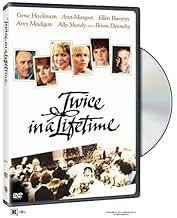
TWICE IN A LIFETIME
US, 1985, 111 minutes, Colour.
Gene Hackman, Ann Margret, Ellen Burstyn, Amy Madigan, Ally Sheedy, Stephen Lang, Brian Dennehy.
Directed by Bud Yorkin.
The cliche is that love is once-in-a-lifetime. The screenplay here raises the question whether it can be twice.
The screenplay is written by British, Colin Welland (soon to win an Oscar for Chariots of Fire). It is a British writer observing and researching in Washington State, in Seattle. The direction is by Bud Yorkin, best known for light entertainment is including The Thief Who Came to Dinner, Start the Revolution Without Me). Which means that the screenplay is both serious and sometimes with a lighter touch.
Gene Hackman is completely persuasive as Harry, steelworker, turning 50, celebrating, attracted by Ann Margret as Audrey at the bar, unsettled in his long marriage to Kate, Ellen Burstyn. There is the attraction, the mutual response, his decision to leave home, the drama of the discussions with Kate, the challenge of his older daughter, Sunny (Amy Madigan in an Oscar nominated performance), and the more sympathetic younger Helen, Ally Sheedy, about to be married.
This is a film of the 1980s – and attitudes towards marriage, separations, divorce became much “freer” in succeeding decades. However, here is a story which can resonate with middle-aged couples throwing some light on the crises.
- Title? Expectations? Treatment of the themes and issues, quality?
- Americana, universal message? Seattle and Washington State locations? The city, the suburbs, factories, bars?
- The themes, perennial? The British screenwriter and his perspectives?
- The realities of situations, midlife crisis, years of work, fulfilment, lack of fulfilment, marriage, love, taking spouses for granted, men and women, stereotypes, idealising of situations? Anger, coping, surviving? The next generation?
- The focus on Harry, Gene Hackman performance, turning 50? Seeing him at home, seeing him at work, his range of friends? The quality of his relationships, individuals? The party, the presence? Kate and his long relationship with her, sleeping, his going out, Kate staying home? The job, Nick? The party, Audrey, the kiss, the opportunity?
- Harry and his behaviour, going out, the car park, nervous, enjoying Audrey’s company, sharing? His stories, memories with Kate? Knowing the reality, the issue of being caught? Confrontation and response? Sunny and her reaction, Audrey and anxiety, Nick and the break? His talking with Kate, angers, with each member at home? Leaving, in the city, the neighbourhood, the apartment? With Audrey, buying the watch, becoming a new man, severing ties, ringing Helen and talking with her, the wedding and his enjoyment? The photo, not going to the party, alone?
- Ellen Burstyn as Kate, long-suffering, the long marriage, at home, supportive of Harry, bringing up the children, relationship with the children? Not noticing his crisis? His leaving, the repercussions, the discussions, angers? And the reaction of the children?
- Sunny, anger, older daughter, the challenge to her father? Her own life? The contrast with Helen, about to be married, Harry’s warming towards her? The preparations for the wedding? His attendance or not?
- Audrey, and Margaret’s glamour, even in the bar? Her work, personality, noticing Harry, the attraction, his response to her, the kiss, her consenting to the affair, the meetings, in the car, the effect on Harry, the effect on her? The future?
- The characters in the background, Nick, at work, his workmates, 50th birthday, the friendship? Helen and the preparations for her wedding, the fiance, the marriage?
- Familiar material? How well written and insightful? How well portrayed? Insight into midlife crisis, its effect on men, on women?
A Downlands College Occasion
A Downlands College Occasion

Fr Vince Carroll – DPSA past President, Bishop Ken Howell - DPSA Patron, Mrs Terrie Wendland – DPSA Vice President, Fr Will Brennan - recently ordained past student, Mr Dan Houghton – DPSA President, Deacon Andrew O’Brien – past student and Past captain ’76, Fr Stephen Hackett MSC Provincial and DPSA Patron, Mr Stephen Koch Downlands Principal and DPSA Patron.
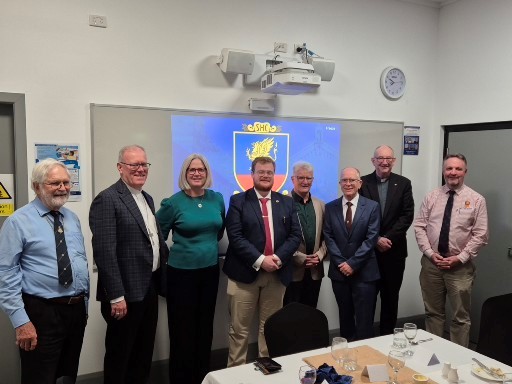
Recently the above were joined by another 7 guests to enjoy a meal of celebration and Get-to-know-you for the Patrons of the DPSA and Fr Will and Deacon O’Brien. It was beautifully catered for by Mr Ben and Mrs Katie Wright and two lovely student servers. The guests agreed it could well become a yearly event honouring some past students who had done well recently.
Fr Vince Carroll MSC
Daramalan College, from Residence to Issoudun Centre
Daramalan College, from Residence to Issoudun Centre

The site of the former MSC Residence now holds the Issoudun Performing Arts Centre.

In the mid-1960s, 24 brothers and priests lived in the Residence, plus two or three in a unit in the Sharpe wing. Quite a number of MSC lived in the Residence over the decades.
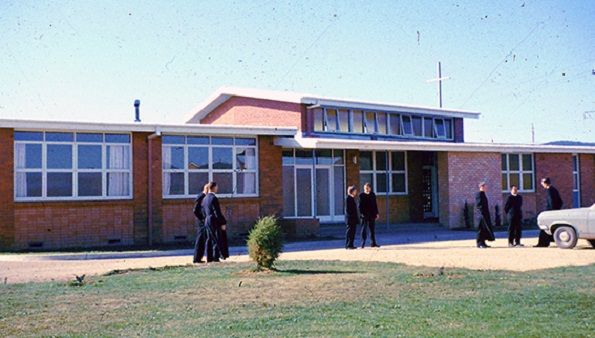
The Issoudun Wing is a two-storey performing arts centre for Daramalan College, created in collaboration with the school team and specialist theatre design consultants.

The centre provides a new home for creativity and expression with a large theatre that will host a range of school gatherings.

The building references the school’s existing architecture, adding to the pattern of planning across the campus and defining the northeast corner of the Dickson site.
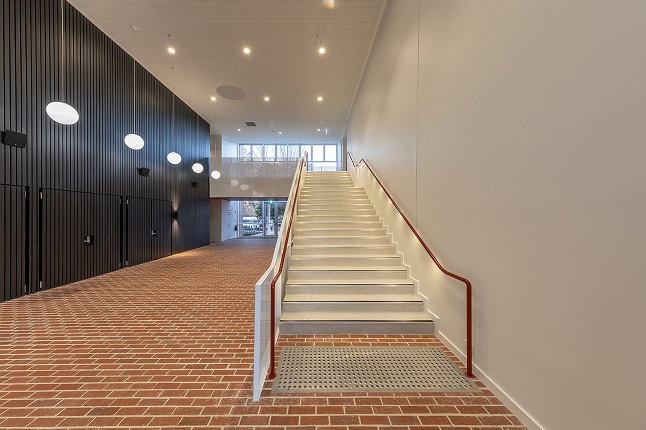
It is called the “Issoudun Wing” after the French town where Fr Jules Chevalier started the MSC order in 1854. The name pays honour to the Daramalan priests and brothers who vacated the site after living there since the 1960s.
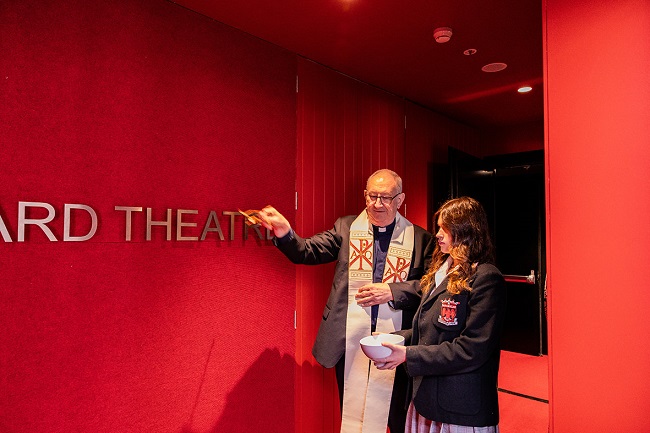
It was blessed and opened on Friday, October 25th at 9:30am,followed by morning tea and a Chevalier Day Liturgy.

The MSC presence was Stephen Hackett, Provincial, Barry Smith, previous in management, Kimi, past chaplain, Tru, present chaplain.
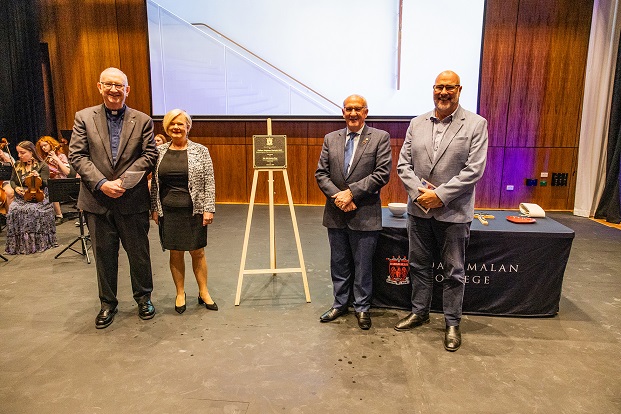
Appreciation to Barry Smith for providing the photos.

Acknowledging Terry Naughton MSC, 85
Acknowledging Terry Naughton MSC, 85
Once again, a tribute to a confrere who turned 85, yesterday, November 3.
Terry is a Queenslander, from Warwick. He made his novitiate in 1958 at Douglas Park but received a diagnosis during that year that he suffered from diabetes. This meant a brief interruption for his novitiate year and he made his profession on August 5, 1959.
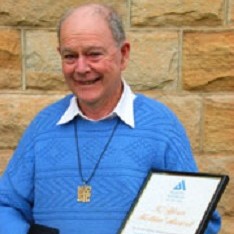
Terry with his living with diabetes medal
During his studies for the priesthood, in Canberra and at Croydon, he spent some time in teacher training. After his ordination, 17th July, 1966, he was appointed to the newly established Daramalan College in Canberra, in charge of the junior school, working with Frank Andersen for many years, until the end of 1978.
There is great significance in Terry's turning 85. When he was diagnosed with diabetes, the doctors informed him that he would not live beyond 40. During the year of his turning 40, Terry and Frank spent a renewal year at the Jesuit Institute in Berkeley, California. Terry wrote a reflective piece about his life, illness, prospects for the length of his life in an article for Compass Theology Review.
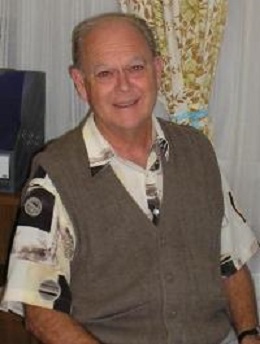
Terry has had quite an extraordinary extra 45 years. He taught at Chevalier College. In 1982, he became director of the MSC Pre-novitiate students at Croydon. In 1987 he was appointed novice master. In later years, he has been living at St Mary’s Towers, Douglas Park, working in spiritual direction, and conducting retreats and spirituality workshops. More recently, he was at Kensington monastery and is now residing at St Joseph’s Nursing Home.
A life of great fortitude – and encouragement to us all.

